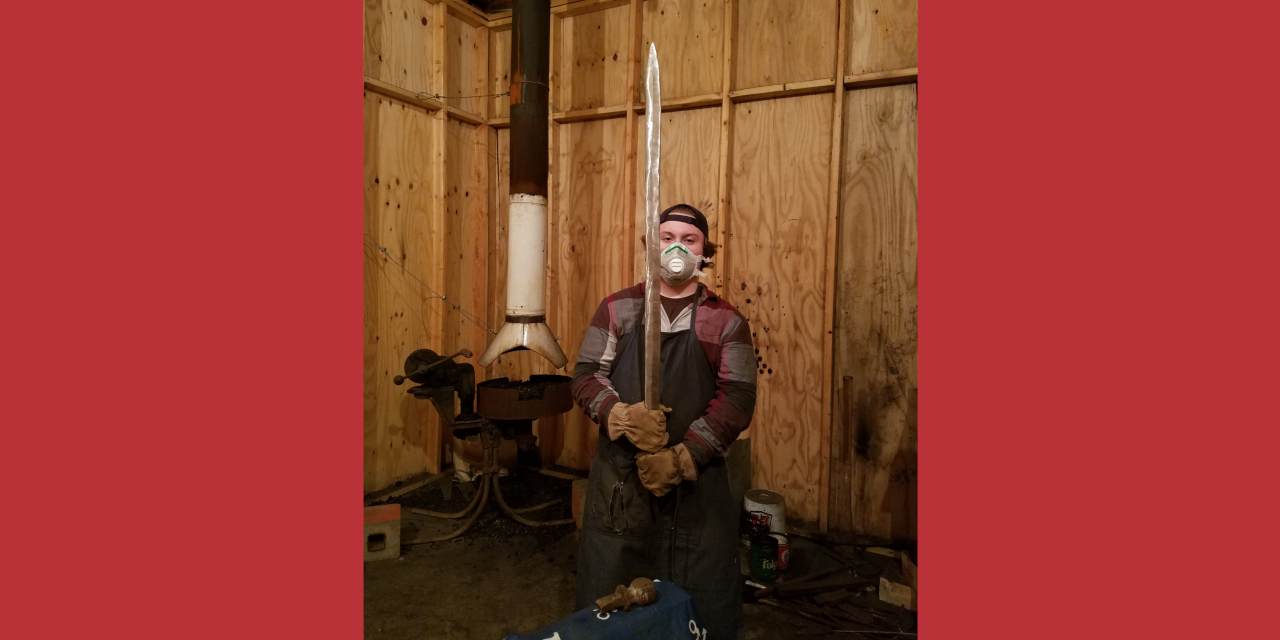Benji Wall got coal for Christmas last year, and it wasn’t the first time.
But Wall, a sophomore communication major with an art minor, was not upset. The coal was merely a part of the “best Christmas gift a wannabe-blacksmith could ever get,” he said.Wall does not remember why he wanted to get into blacksmithing.
“But I just had this urge to, like, learn how to blacksmith,” he said. “I honestly cannot remember what sparked that; I guess curiosity.”
Wall’s parents secretly spoke to his great-uncle, a retired blacksmith. His great-uncle gave his blacksmith workshop to Wall, which Wall had never seen before. The shop was equipped with three 55-pound barrels of coal, an anvil, wood stove, work table and a five-gallon bucket full of tongs, frozen in water and rusted shut.
Wall’s mom then found a blacksmith on the internet in Middlebury, Indiana, named Curt Lyles, who taught him how to blacksmith.
Wall brought his anvil and, over two days, learned how to use his newly acquired workshop.
Wall’s first completed item was a coal rake, a two-foot tool with a flattened end, “kinda like a hoe, but narrow,” which is used to rake coal inside of the forge.
The next item he made, a sign post, was made from two pieces using two holes drilled into the post. The sign post has stood in the Walls’ family yard for five years.
Like most things, blacksmithing is a process.
Wall lights the fire of his forge using double pieces of newspaper, rolled into a nest shape. The “nest” is placed in the forge upside down in a premade divot in the coal.
Next, Wall places coal over the nest and cranks the blower handle, “which blows air through pipes from underneath so that air goes up from the bottom,” he said.
To successfully start the fire, Wall has to crank the blower handle for 15 minutes for the coal to get “cooked,” burning out the impurities. The impurities “come out in like a yellow-green smoke; it’s kinda gross.”
Wall’s most commonly made item is wall hooks, made from horseshoe nails. The “stock,” as the metal is called, is then squared up, which means turning the metal 90° and hammering that side until it is square.
Next, Wall tapers the end that becomes the hook. For decorations, the top part of the hook can also be looped.
“And once it’s finished,” Wall said, “I cool it off in a bucket of water, and later I drill a hole in it, or two holes in the bigger hooks.”
Wall sometimes uses plaster of paris to hold hooks in place, and uses a propane, hand-held torch to heat up horseshoe nails for drilling.
But Wall’s favorite, and most complex, item he has made was a sword for his high school’s production of Camelot.
The blade, about three feet long, required help to complete.
Cade Fisher, a junior peace, justice and conflict studies major, was also in the musical and helped Wall make the sword. Fisher acted as the striker.
“There’s the blacksmith who was moving the metal and then there’s the striker who’s actually striking the metal,” Wall explained, “And that helped the process go much faster than what I could have done.”
“Smithing that sword with Benji was such a fun, interesting experience,” Fisher said. “My back was sore for several days afterward.”
Once the blade was flattened, Wall used his four-pound hammer to bevel the sides to form the angled edges of a blade.
Wall had to cut off eight inches because the blade was too long, and reshaped the tip. Next, he had to grind the blade, which took a week to get it how he liked it. The grinding made the metal very hot but his crunch bucket, used to quench and cool the metal, was only one-and-a-half feet deep.
“So I took it to my pond to punch it in there,” Wall said.
Wall rounded the edges to ensure that it would not be able to cut anything. For the crossguard, Wall took a piece of metal and used his high school machine shop’s mill to make a hole for the pommel.
The pommel was made using a trailer hitch. Wall flattened the sides and formed a cross pattern.
To add the pieces together, he went to his neighbor, a welder. Wall then put wood on the heels, wrapped it in fake leather and it was done.
“I realized how important the counterweight at the end of the handle was for a balanced sword,” Fisher said.
The sword weighed eight to 10 pounds, while a normal sword should weigh less than a pound, Wall said.
The sword was too heavy to be used in the show, but was put in a lobby display cabinet. Once the show concluded, Wall took the sword home and still owns it.
Wall has not worked with any other blacksmiths. He did apply to join the Indiana Blacksmithing Association, but later decided not to join. He mostly works with friends and shows them how to make items such as spoons.
Anyone interested in blacksmithing should “do some research on what it entails, what [types] of blacksmithing there are, coal or propane,” Wall said. “If there’s a blacksmith in your area, contact them and see if they show you some blacksmithing.”



